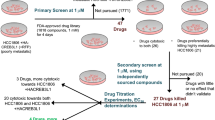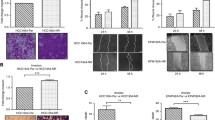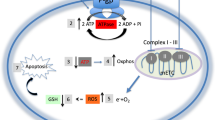Abstract
Compounds within the 2-(4-aminophenyl)benzothiazole class represent extremely potent and selective experimental antitumour agents. The lysylamide prodrug of 2-(4-amino-3-methylphenyl)-5-fluorobenzothiazole is undergoing phase I clinical evaluation. Extensive studies to elucidate mechanisms underlying the stark selectivity demonstrated potent cytosolic AhR ligand binding and cytochrome P450 1A1-catalysed bioactivation. Two human derived breast cell lines, initially exquisitely sensitive to this class of agent (GI50 < 5 nM) have been derived displaying acquired resistance to 2-(4-amino-3-methylphenyl)benzothiazole (DF 203; GI50 > 50 μM). Cross resistance to 2-(4-amino-3-iodophenyl)benzothiazole and 2-(4-amino-3-cyanophenyl)benzothiazole is observed (GI50 > 30 μM) as is > 100-fold reduced sensitivity of the two variant lines to 2-(4-amino-3-methylphenyl)-5-fluorobenzothiazole (5F 203). In contrast, cell lines possessing acquired resistance to DF 203 (203R) retain sensitivity to benzo[a]pyrene and doxorubicin. Examination of DF 203-treated cells by confocal microscopy and HPLC analyses of nutrient media concur revealing diminished depletion of DF 203 from medium and impaired intracellular DF 203 retention. In contrast to cytosolic arylhydrocarbon (AhR) receptors of wild type cells, AhR appears constitutively localised within nuclei of 203R cells; consequently, DF 203 fails to drive transcription of cyp1a1. DF 203- and 5F 203-derived DNA adducts fall significantly in 203R cells. Reduced number and intensity of γH2AX foci report protection against DF 203-evoked DNA double strand breaks. In conclusion, aberrant AhR signalling underlies at least in part acquired resistance to DF 203. Intriguingly, comparisons of gene transcription profiles between sensitive and resistant paired lines reveal > 5-fold up-regulation of cyp1b1 expression, a protein implicated in resistance to therapeutic agents.








Similar content being viewed by others
Abbreviations
- Ab:
-
Antibody
- ADPRT:
-
ADP ribosyl transferase
- AhR:
-
Arylhydrocarbon receptor
- B[a]P:
-
Benzo[a]pyrene
- cy:
-
Cyanine
- CYP1A1:
-
Cytochrome P450 1A1
- CYP1B1:
-
Cytochrome P450 1B1
- DF 129:
-
2-(4-amino-3-iodophenyl)benzothiazole
- DF 203:
-
2-(4-amino-3-methylphenyl)benzothiazole
- DMSO:
-
Dimethylsulphoxide
- DSB:
-
Double strand break
- ER:
-
Oestrogen receptor
- 5F 203:
-
2-(4-amino-3-methylphenyl)-5-fluorobenzothiazole
- GI50 :
-
Agent concentration which inhibits growth by 50%
- γH2AX:
-
Serine 139 phosphorylation of histone H2AX
- HPLC:
-
High performance liquid chromatography
- IH 191:
-
2-(4-amino-3-cyanophenyl)benzothiazole
- MTT:
-
3-(4,5-dimethylthiazol-2-yl)-2,5-diphenyltetrazolium bromide
- PBS:
-
Phosphate-buffered saline
- PD:
-
Pharmacodynamic
- 203R:
-
DF 203-resistance
- Rt:
-
Retention time
- TCDD:
-
2,3,7,8-tetrachlorodibenzo-p-dioxin
- TK:
-
Thymidine kinase
- wt:
-
Wild type
References
Goldie JH, Coldman AJ (1998) Molecular aspects of drug resistance. In Drug Resistance in Cancer. Mechanisms and Models, Cambridge University Press, UK, pp 59–89
Mashima T, Tsuruo T (2005) Defects of the apoptotic pathway as therapeutic target against cancer. Drug Resist Updat 8:339–343
Cowan KH, Goldsmith ME, Levine RM, Aitken SC, Douglass E, Clendeninn N, Niehuis AW, Lippman NE (1982) Dihydrofolate reductase gene amplification and possible rearrangement in estrogen-responsive methotrexate-resistant human breast cancer cells. J Biol Chem 257:15079–15086
Akman SA, Forrest G, Chu FF, Esworthy S, Doroshow JH (1990) Antioxidant and xenobiotic-metabolizing enzyme gene expression in doxorubicin-resistant MCF-7 breast cancer cells. Cancer Res 50:1397–1402
Katzenellebogen BS, Kendra KL, Norman MJ, Berthois Y (1987) Proliferation, hormonal responsiveness, and estrogen receptor content of MCF-7 human breast cancer cells grown in the short-term and long-term absence of estrogens. Cancer Res 47:4355–4360
Jiang S, Wolf DM, Yingling JM, Chang C, Jordan VC (1992) An estrogen receptor positive MCF-7 clone that is resistant to antiestrogens and estradiol. Mol Cell Endocrinol 90:77–86
Cowan KH, Batist G, Talpule A, Sinha BK, Myers CE (1986) Similar biochemical changes associated with multidrug resistance in human breast cancer cells and carcinogen-induced resistance to xenobiotics in rats. Proc Natl Acad Sci USA 83:9328–9332
Moore M, Wang X, Lu Y-F, Wormke M, Craig A, Gerlach JH, Burghardt R, Barhoumi R, Safe S (1994) Benzo[a]pyrene-resistant MCF-7 human breast cancer cells. J Biol Chem 269:11751–11759
Trapani V, Patel V, Leong CO, Ciolino HP, Yeh GC, Hose C, Trepel JB, Stevens MFG, Sausville EA, Loaiza-Perez AI (2003) DNA damage and cell cycle arrest induced by 2-(4-amino-3-methylphenyl)-5-fluorobenzothiazole (5F 203, NSC 703786) is attenuated in aryl hydrocarbon receptor deficient MCF-7 cells. Br J Cancer 88:599–605
Bradshaw TD, Westwell AD (2004) The development of the antitumour benzothiazole prodrug, Phortress, as a clinical candidate. Curr Med Chem 11:1009–1023
Bradshaw TD, Fichtner I, Bibby MJ, Double JA, Cooper PA, Alley MC, Tomaszewjski JE, Donahue S, Stinson SF, Sausville EA, Stevens MFG (2002) Preclinical evaluation of amino acid prodrugs of novel antitumor 2-(4-amino-3-methylphenyl)benzothiazoles. Mol Cancer Ther 1:239–246
Bradshaw TD, Chua M-S, Browne HL, Trapani V, Sausville EA, Stevens MFG (2002) In vitro evaluation of amino acid prodrugs of novel antitumour 2-(4-amino-3-methylphenyl)benzothiazoles. Br J Cancer 86:1348–1354
Loaiza-Perez A, Trapani V, Hose C, Singh SS, Trepel J, Stevens MFG, Bradshaw TD, Sausville EA (2002) The aryl hydrocarbon receptor mediates sensitivity of MCF-7 breast cancer cells to the antitumor agent 2-(4-aminophenyl)benzothiazole. Mol Pharmacol 61:13–19
Kashiyama E, Hutchinson I, Chua M-S, Stinson SF, Phillips LR, Kaur G, Sausville EA, Bradshaw TD, Westwell AD, Stevens MFG (1999) Antitumor benzothiazoles. 8. Synthesis, metabolic formation and biological properties of the C-and N-oxidation products of antitumor 2-(4-aminopheny)benzothiazoles. J Med Chem 42:4172–4184
Chua M-S, Kashiyama E, Bradshaw TD, Stinson SF, Brantley E, Sausville EA, Stevens MFG (2000) Role of CYP1A1 in modulation of antitumor properties of the novel agent 2-(4-amino-3-methylphenyl)benzothiazole (DF 203, NSC 674495) in human breast cancer cells. Cancer Res 60:5196–5203
Leong C-O, Gaskell M, Martin EA, Heydon RT, Farmer PB, Bibby MC, Cooper PA, Double JA, Bradshaw TD, Stevens MFG (2003) Antitumour 2-(4-aminophenyl)benzothiazoles generate DNA adducts in sensitive tumour cells in vitro and in vivo. Br J Cancer 88:470–477
Hutchinson I, Chua M-S, Browne HL, Trapani V, Bradshaw TD, Westwell AD, Stevens MFG (2001) Antitumor benzothiazoles. 14. The synthesis and in vitro biological properties of fluorinated 2-(4-aminophenyl)benzothiazoles. J Med Chem 44:1446–1455
Bradshaw TD, Wrigley S, Shi D-F, Schultz RJ, Paull KD, Stevens MFG (1998) 2-(4-Aminophenyl)benzothiazoles: novel agents with selective profiles of in vitro and in vivo activity. Br J Cancer 77:745–752
Fichtner I, Monks A, Hose C, Stevens MFG, Bradshaw TD (2004) The experimental antitumor agent Phortress and doxorubicin are equiactive against human-derived breast carcinoma xenograft models. Breast Cancer Res Treat 87:97–107
Berghard A, Gradin K, Pongratz I, Whitelaw M, Poellinger L (1993) Cross coupling of signal transduction pathways: the dioxin receptor mediates induction of cytochrome P-4501A1 expression via protein kinase C-dependent mechanism. Mol Cell Biol 13:677–689
Nordeen SK (1988) Luciferase reporter gene vectors for analysis of promoters and enhancers. Biotechniques 6:454–457
Gupta RC (1985) Enhanced sensitivity of 32P-postlabeling analysis of aromatic carcinogen-DNA adducts. Cancer Res 45:5656–5662
Reddy MV, Randerath K (1986) Nuclease P1-mediated enhancement of sensitivity of 32P-postlabeling test for structurally diverse DNA adducts. Carcinogenesis 7:1543–1551
Clarke PA, te Poele R, Wooster R, Workman P (2001) Gene expression microarray analysis in cancer biology, pharmacology, and drug development: progress and potential. Biochem Pharmacol 62:1311–1336
Rogakou EP, Pilch DR, Orr AH, Ivanova VS, Bonner WM (1988) DNA double-stranded breaks induce histone H2AX phosporylation on serine 139. J Biol Chem 273:5858–5868
Hayes JD, Wolf CR (1990) Molecular mechanisms of drug resistance. Biochem J 272:281–295
Yeh GC, Daschner PJ, Lopaczynska J, MacDonald CJ, Ciolino HP (2001) Modulation of glucose-6-phosphate dehydrogenase activity and expression is associated with aryl hydrocarbon resistance in vitro. J Biol Chem 276:34708–34713
Degen GH, Vogel C, Abel J (2001) Prostaglandin synthases. In: Ioannides C (ed) Enzyme systems that metabolise drugs and other xenobiotics. John Wiley & Sons Ltd, pp 189–229
Leong C-O, Suggitt M, Swaine DJ, Bibby MC, Stevens MFG, Bradshaw TD (2004) In vitro, in vivo and in silico analyses of the antitumor activity of 2-(4-amino-3-methylphenyl)-5-fluorobenzothiazoles. Mol Can Ther 3:1565–1575
Lockett KL, Hall MC, Xu J, Zheng SL, Berwick M, Chuang SC, Clark PE, Cramer SD, Lohmen K, Hu J (2004) The ADPRT V62A genetic variant contributes to prostate cancer susceptibility and deficient enzyme function. Cancer Res 64:6344–6348
McFadyen MCE, McLeod HL, Jackson FC, Melvin WT, Doehmer J, Murray GI (2001) Cytochrome P450 CYP1B1 protein expression: a novel mechanism of anticancer drug resistance. Biochem Pharmacol 62:207–212
Rochat B, Morsman JM, Murray GI, Fiff WD, McLeod HL (2001) Human CYP1B1 and anticancer agent metabolism: mechanism for tumor-specific drug inactivation. J. Phamacol Exp Ther 296:537–541
Bandiera S, Weidlich S, Harth V, Broede P, Ko Y, Friedberg T (2005) Proteasomal degradation of human CYP1B1: effect of the Asn435Ser polymorphism on the post-translational regulation of CYP1B1 expression. Mol Pharmacol 67:435–443
Sissung TM, Price DK, Sparreboom A, Figg WD (2006) Pharmacogenetics and regulation of human cytochrome P450 1B1: implications in hormone-mediated tumor metabolism and a novel target for therapeutic intervention. Mol Can Res 4:135–150
Acknowledgement
Authors would like to thanks Professor Paul Workman for collaboration.
Author information
Authors and Affiliations
Corresponding author
Additional information
Part 28 in the “Antitumour Benzothiazoles” series.
Rights and permissions
About this article
Cite this article
Bradshaw, T.D., Stone, E.L., Trapani, V. et al. Mechanisms of acquired resistance to 2-(4-Amino-3-methylphenyl)benzothiazole in breast cancer cell lines. Breast Cancer Res Treat 110, 57–68 (2008). https://doi.org/10.1007/s10549-007-9690-9
Received:
Accepted:
Published:
Issue Date:
DOI: https://doi.org/10.1007/s10549-007-9690-9




